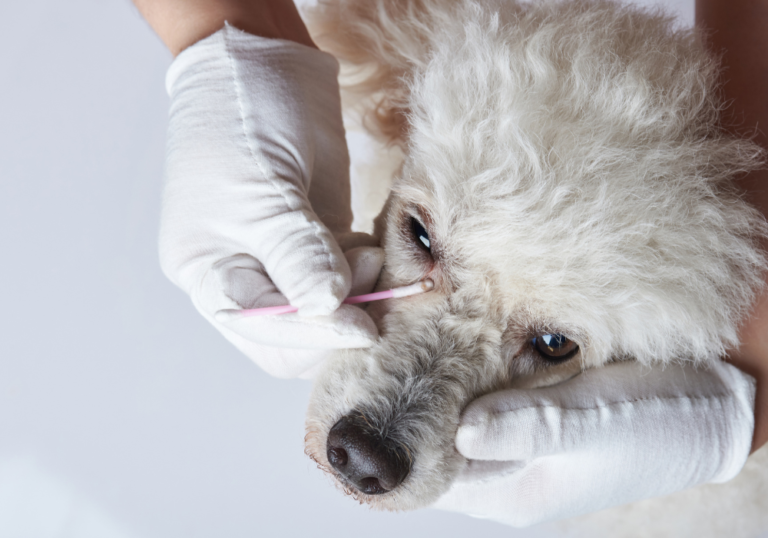Dog Eye Infection: Symptoms & Treatment

A dog’s eyes can become affected by infections just like ours. Vision is an invaluable sense, so it’s always best to err on the side of caution if you suspect your dog has a problem with their eyes. Dog eye infections can appear out of nowhere and quickly become uncomfortable for your furry friend.
You may notice your dog pawing at their eye in an attempt to find relief from the discomfort, or you might see redness accompanied by unusual discharge. If you observe these symptoms, it’s time to consult our doctors at Acacia Pet Clinic for expert advice on your dog’s eye health.
What Are the Most Common Types of Eye Infections in Dogs?
Dog eye infections can manifest in various ways. The most common types include:
- Canine Conjunctivitis: This occurs when the membrane lining the outer portion of the eyeball becomes inflamed.
- Canine Uveitis: This term refers to infections affecting the structures within the eye, such as the iris.
- Canine Keratitis: This involves inflammation and infection of the cornea.
Dog Eye Infection Symptoms
Recognizing the symptoms of a dog eye infection is crucial for timely treatment. Common signs include:
- Swelling around the eye
- Eye redness
- Eye discharge (which can be watery, white, reddish-brown, yellow, or green)
- Excessive blinking or squinting
- Light sensitivity
- Pawing at the affected eye
If you notice any of these symptoms, it’s essential to contact our doctors at Acacia Pet Clinic as soon as possible. While eye infections in dogs are not typically life-threatening, they can be very uncomfortable and may indicate underlying health issues that require attention. Moreover, many seemingly trivial eye problems can lead to permanent eyesight damage if left untreated.
What Are the Causes of Eye Infections in Dogs?
Eye infections in dogs can result from a variety of factors. Here are some of the most common causes:
- Bacterial infections
- Viral infections
- Allergies
- Trauma to the eye
- Foreign bodies, such as grass seeds
- Tumors
- Fungal infections
- Irritants like dust or smoke
- Other eye diseases, such as dry eye or glaucoma
- Eye abnormalities, such as cherry eye
While many eye problems in dogs are not contagious, it is wise to limit contact with other pets in the household until your dog has been examined by our doctors at Acacia Pet Clinic.
Dog Eye Infection Treatment
Noticing redness or unusual discharge in your dog’s eyes can be alarming, but fortunately, there are many effective treatments for eye infections. The treatment plan your vet recommends will depend on the specific type of infection or eye problem identified.
- Bacterial Infections: Typically treated with antibiotics.
- Allergic Reactions: May require antihistamines or anti-inflammatory medications.
- Surgical Intervention: Sometimes necessary for addressing eyelash abnormalities or blocked tear ducts.
Can Dog Eye Infections Be Prevented?
Preventing dog eye infections can be challenging, especially since dogs love to explore their environments. However, there are measures you can take to protect your dog’s eyes:
- Dog Goggles: Consider using protective eyewear for adventurous dogs, particularly those that enjoy hiking or exploring off the beaten path. It may take some time for your dog to adjust to wearing goggles, so patience is essential.
- Grooming: Keeping the hair around your dog’s eyes short can help prevent irritation. However, it’s best to seek professional grooming assistance to avoid any accidents near the eyes.
Conclusion
If you suspect your dog may have an eye infection, don’t hesitate to consult our doctors at Acacia Pet Clinic for an accurate diagnosis and appropriate treatment. Taking swift action can help ensure your furry friend remains comfortable and healthy.
If you need more help or have any questions, call us at Acacia Pet Clinic, (408) 264-6354, 4486 Pearl Ave, San Jose, CA 95136,
Hours: Monday-Friday: 8:00 am – 5:00 pm*

